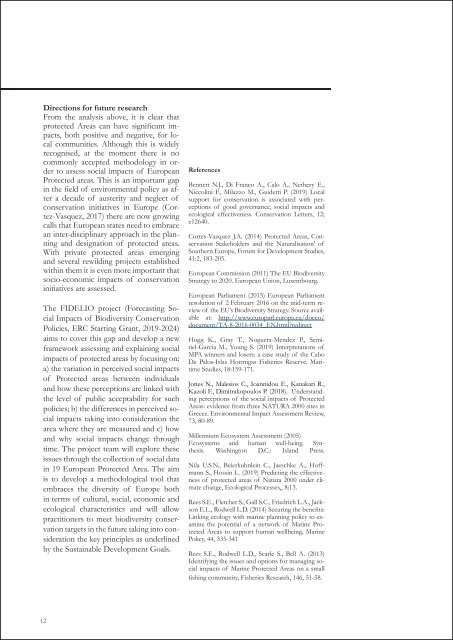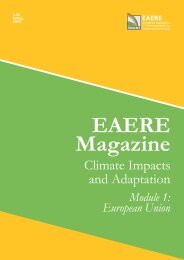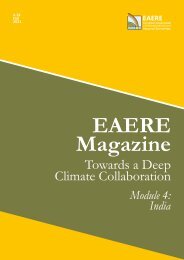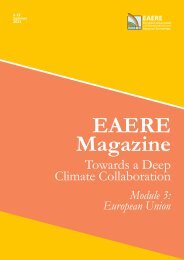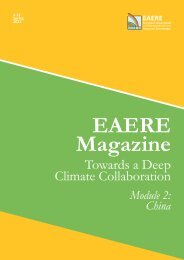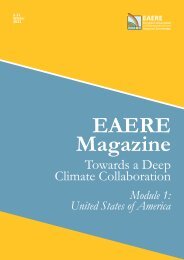EAERE Magazine - n.7 Fall 2019
You also want an ePaper? Increase the reach of your titles
YUMPU automatically turns print PDFs into web optimized ePapers that Google loves.
Directions for future research<br />
From the analysis above, it is clear that<br />
protected Areas can have significant impacts,<br />
both positive and negative, for local<br />
communities. Although this is widely<br />
recognised, at the moment there is no<br />
commonly accepted methodology in order<br />
to assess social impacts of European<br />
Protected areas. This is an important gap<br />
in the field of environmental policy as after<br />
a decade of austerity and neglect of<br />
conservation initiatives in Europe (Cortez-Vasquez,<br />
2017) there are now growing<br />
calls that European states need to embrace<br />
an inter-disciplinary approach in the planning<br />
and designation of protected areas.<br />
With private protected areas emerging<br />
and several rewilding projects established<br />
within them it is even more important that<br />
socio-economic impacts of conservation<br />
initiatives are assessed.<br />
The FIDELIO project (Forecasting Social<br />
Impacts of Biodiversity Conservation<br />
Policies, ERC Starting Grant, <strong>2019</strong>-2024)<br />
aims to cover this gap and develop a new<br />
framework assessing and explaining social<br />
impacts of protected areas by focusing on:<br />
a) the variation in perceived social impacts<br />
of Protected areas between individuals<br />
and how these perceptions are linked with<br />
the level of public acceptability for such<br />
policies; b) the differences in perceived social<br />
impacts taking into consideration the<br />
area where they are measured and c) how<br />
and why social impacts change through<br />
time. The project team will explore these<br />
issues through the collection of social data<br />
in 19 European Protected Area. The aim<br />
is to develop a methodological tool that<br />
embraces the diversity of Europe both<br />
in terms of cultural, social, economic and<br />
ecological characteristics and will allow<br />
practitioners to meet biodiversity conservation<br />
targets in the future taking into consideration<br />
the key principles as underlined<br />
by the Sustainable Development Goals.<br />
References<br />
Bennett N.J., Di Franco A., Calo A., Nethery E.,<br />
Niccolini F., Milazzo M., Guidetti P. (<strong>2019</strong>) Local<br />
support for conservation is associated with perceptions<br />
of good governance, social impacts and<br />
ecological effectiveness. Conservation Letters, 12;<br />
e12640.<br />
Cortes-Vazquez J.A. (2014) Protected Areas, Conservation<br />
Stakeholders and the Naturalisation’ of<br />
Southern Europe, Forum for Development Studies,<br />
41:2, 183-205.<br />
European Commission (2011) The EU Biodiversity<br />
Strategy to 2020. European Union, Luxembourg.<br />
European Parliament (2015) European Parliament<br />
resolution of 2 February 2016 on the mid-term review<br />
of the EU’s Biodiversity Strategy. Source available<br />
at: http://www.europarl.europa.eu/doceo/<br />
document/TA-8-2016-0034_EN.html?redirect<br />
Hogg K., Gray T., Noguera-Mendez P., Semitiel-Garcia<br />
M., Young S. (<strong>2019</strong>) Interpretations of<br />
MPA winners and losers: a case study of the Cabo<br />
De Palos-Islas Hormigas Fisheries Reserve. Maritime<br />
Studies, 18:159-171.<br />
Jones N., Malesios C., Ioannidou E., Kanakari R.,<br />
Kazoli F., Dimitrakopoulos P. (2018). Understanding<br />
perceptions of the social impacts of Protected<br />
Areas: evidence from three NATURA 2000 sites in<br />
Greece. Environmental Impact Assessment Review,<br />
73, 80-89.<br />
Millennium Ecosystem Assessment (2005)<br />
Ecosystems and human well-being. Synthesis.<br />
Washington D.C.: Island Press.<br />
Nila U.S.N., Beierkuhnlein C., Jaeschke A., Hoffmann<br />
S., Hossin L. (<strong>2019</strong>) Predicting the effectiveness<br />
of protected areas of Natura 2000 under climate<br />
change, Ecological Processes,, 8:13.<br />
Rees S.E., Fletcher S., Gall S.C., Friedrich L.A., Jackson<br />
E.L., Rodwell L.D. (2014) Securing the benefits:<br />
Linking ecology with marine planning policy to examine<br />
the potential of a network of Marine Protected<br />
Areas to support human wellbeing, Marine<br />
Policy, 44, 335-341<br />
Rees S.E., Rodwell L.D., Searle S., Bell A. (2013)<br />
Identifying the issues and options for managing social<br />
impacts of Marine Protected Areas on a small<br />
fishing community, Fisheries Research, 146, 51-58.<br />
12


